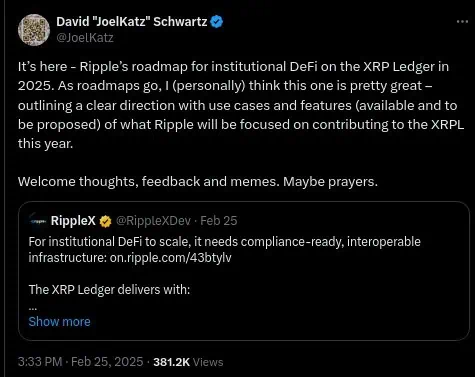
The XRP Ledger (XRPL), one of the most mature and trusted blockchains in the crypto ecosystem, is preparing for a year full of innovation and significant improvements.
Its CTO, David Schwartz, recently unveiled the XRP Ledger roadmap for 2025, an ambitious plan that seeks to strengthen the network’s capabilities in key areas such as programmability, regulatory compliance, and institutional adoption in DeFi.
Known for its speed, efficiency, and low transaction cost, XRPL is already a versatile platform for cross-border payments, asset tokenization, and decentralized financial solutions. However, upcoming upgrades promise to take the network to a new level, allowing developers to build custom functionalities without compromising the security and scalability that have positioned XRPL as an attractive option for financial institutions.
The improvements announced by Schwartz include the Introduction of credentials, multi-purpose tokens and lending tools, among other innovations. These updates are not only designed to bolster XRPL’s competitiveness in the DeFi space, but will also open up new opportunities for real-world asset tokenization and marketplace automation.
The future of programmability in XRPL
One of the fundamental pillars of the Roadmap XRPL’s vision for 2025 is the introduction of greater programmability to the network. While XRPL already has a solid architecture, the addition of new custom functionality will allow developers to expand its capabilities without affecting the integrity of the federated consensus that characterizes the blockchain.
According to Schwartz, the approach will be gradual, with an emphasis on implementing "Extensions“, which are small code modules that integrate with existing network functionalities such as escrows, tokens, and the decentralized exchange (DEX). These extensions will allow developers to add custom logic in a lightweight and efficient manner, reducing complexity while maintaining security.
A prominent example is the launch of Smart Escrows, which will offer customizable conditions for releasing funds. For example, “notarized escrows” will allow only a specific account to unlock funds, while “credential-based escrows” will require the recipient to possess a specific NFT or credential to access the resources.

Additionally, XRPL also plans to introduce an Ethereum Virtual Machine (EVM)-compatible sidechain, which will allow developers to run smart contracts in a secure and efficient environment. This integration will not only attract more projects to the ecosystem but will also enable interoperability with other blockchains.
PREPARE YOUR WALLETImprovements in regulatory compliance and token management
Regulatory compliance is a crucial aspect of attracting financial institutions to the DeFi space. Aware of this, Ripple has included significant improvements in this area in its roadmap, such as the introduction of “Credentials" Y "Multi-Purpose Tokens» (MPTs).
Credentials represent a step forward in decentralized identity (DID), allowing users to prove specific criteria, such as age verification or regulatory status, without relying on centralized intermediaries. These credentials will be critical to the implementation of permissioned decentralized exchanges (DEXs), where institutions will be able to operate securely and comply with AML and KYC regulations.
On the other hand, MPTs are a new standard for asset tokenization that combines the features of fungible and non-fungible tokens. This solution allows institutions to represent complex assets, such as bonds or stocks, on the blockchain, including essential metadata such as maturity dates. MPTs offer greater flexibility than fungible tokens, but without the uniqueness of NFTs, making them an ideal tool for institutional use cases.
“With deep liquidity, compliance-friendly features, and seamless institutional integration, the next phase of Institutional DeFi will be built on XRPL”, its developers assured.
Finally, the function of clawback has been optimized for use in automated liquidity pools (AMMs), allowing token issuers to recover assets in the event of illegal activities or regulatory requests. This functionality not only strengthens the security of the network, but also fosters trust between institutions and users.
BUY RIPPLE HEREExpanding lending capabilities and institutional DeFi
The institutional DeFi ecosystem is another key focus of XRPL’s roadmap for 2025. With the launch of new lending tools, Ripple seeks to facilitate the integration of financial institutions into the DeFi space, allowing them to offer innovative products and services without banking intermediaries.
Among the novelties is a loan system which will use a default Ripple USD (RLUSD) vault to reduce liquidity fragmentation and optimize market operations. Additionally, the implementation of AMMs at the protocol level will allow institutions to provide liquidity and earn rewards, improving market efficiency and reducing reliance on centralized exchanges.
La tokenization of real-world assets (RWA) This will also be an expanding area. By allowing for the digital representation of real estate, commodities, and other illiquid assets, XRPL opens up new opportunities for decentralized investment and finance. For example, investors will be able to access parts of a tokenized real estate asset, democratizing access to markets previously reserved for large investors.
All of these improvements not only cement XRPL as a leading DeFi platform, but also set a precedent for institutional adoption of blockchain technology in the near future.
INVITE AND WINIn conclusion, XRPL’s roadmap to 2025, as laid out by Schwartz, represents an important milestone in the evolution of blockchain. With a focus on programmability, regulatory compliance, and expanding institutional DeFi capabilities, XRPL is set to establish itself as a leading platform in the decentralized finance space.
Investing in cryptoassets is not fully regulated, may not be suitable for retail investors due to high volatility and there is a risk of losing all invested amounts.



